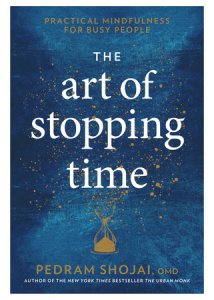
by Emma Warnken Johnson
Mindfulness is everywhere these days. There seems to be an endless supply of books, articles, and apps touting its benefits. The practices vary, but they all seek to focus the mind on the present moment, shedding distractions and helping us appreciate the little things in our lives. I’ve been meaning to try mindfulness for quite some time, but never seem to be able to fit it into my busy schedule.
This makes The Art of Stopping Time: Practical Mindfulness for Busy People a timely book for me, and I suspect it will be for a lot of other busy editors too. Taoist monk and Qi Gong master Pedram Shojai adapts the 100-day Gong—a traditional Taoist practice—to create a mindfulness routine that can fit into a busy schedule. The book is divided into 100 short chapters, and each one describes a brief daily activity that promotes mindfulness and a healthier relationship to the way we think about and spend our time.
The activities vary widely. Readers are asked to do some breathing exercises, to stretch and relax their muscles, and to eat a meal without the distraction of other activities (like watching TV). Some days include simple activities designed to give your mind a short break, like going for a walk, taking a bath, or making a cup of tea—and several of these seem tailor-made for an editor who takes regular breaks to improve productivity. Other days are more reflective, asking you to think about how you spend their time and review your priorities. Reading through the activities, I found several that I thought I would enjoy and could easily integrate into my daily schedule.
But there were other activities that I either couldn’t or wouldn’t want to do, and this is the real flaw of the book: it would be almost impossible to use it as intended, completing all 100 activities in 100 days. I suspect every reader will find a few activities that they can’t complete, and others that they won’t feel comfortable doing. A short activity like going outside to sprint up and down the street will not be possible for those with physical and health restrictions. One day is designed to make better use of your time stuck in traffic—but I don’t even own a car. In cases like these, no alternative activity is presented.
To his credit, the author does address this, encouraging people to know their limits and adapt the activities to their needs and abilities. But I personally found it distracting to have to weigh each activity against the realities of my own life, rather than being able to trust that each day I could open the book and complete the activity presented to me.
But if you view the book as a general resource, editors will find many of the activities useful and easy to incorporate into their lives. Editing requires a great deal of mental focus, not to mention the physical strain of sitting for long hours, and both challenges benefit from the brief mindfulness techniques presented in the book. Activities that focus on reflection and life planning might also help freelancers sort out their priorities and plan their daily schedules more efficiently.
Overall, the book encourages us to think carefully about how we spend our time, and to be more deliberate and reflective in our choices; it’s hard to imagine a person who wouldn’t benefit from that.
Emma Warnken Johnson is a freelance editor and indexer specializing in academic and trade non-fiction. Find her on her website (www.emmawjohnson.com) and on Twitter (www.twitter.com/warnken).
This article was copy edited by Sarah Newman.
